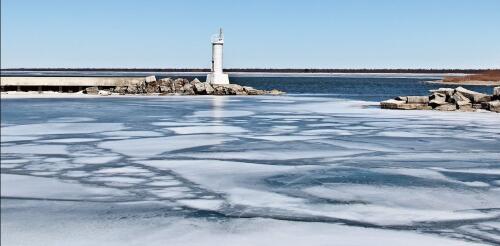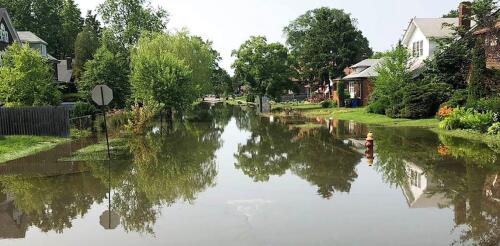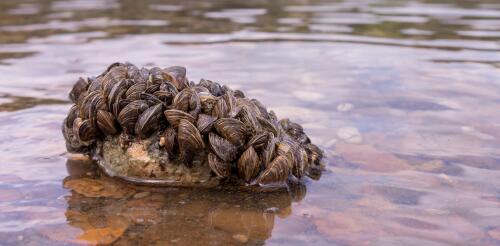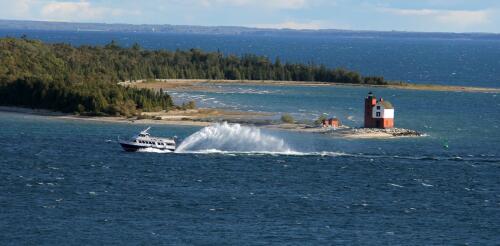Great Lakes
Winters on the Great Lakes are harsh – so much so that the scientists who work there often focus on the summer months, when tiny microbes at the base of the food chain were thought to be most productive. However, emerging research is changing our understanding of these winter ecosystems and shining a light on a vibrant world of winter activity just below the ice. Scientists discovered in the early 2000s that communities of diatoms – tiny photosynthesizing algae – were thriving in the light under the wind-swept lake ice. But, it turns out, that was only part of the story. As the Great Lakes’ winter ice disappears – it hit record lows in the winter of 2023-24 – new analyses show that some diatoms appear to have a different way to create energy and survive in the dark, turbid ice-free water until summer. A thin slice of Lake Erie ice collected by a scientist has diatom algae growing on the bottom....
In 2021, metro Detroit was hit with a rainstorm so severe that President Joe Biden issued a major disaster declaration at state officials’ request. Nearly 8 inches of rain fell within 24 hours, closing every major freeway and causing massive damage to homes and businesses. The storm was of a severity historically seen in Detroit every 500 to 1,000 years. But over the past decade, the region has experienced several other storms only slightly less destructive, one in August 2023. As the planet warms, severe rains – and the flooding that follows – may become even more intense and frequent in cities like Detroit that have aging and undersized stormwater infrastructure. These extreme events put enormous pressure on communities, but low-income urban neighborhoods tend to suffer the most I am a geomorphologist at the University of Michigan-Dearborn specializing in urban environments, water, historical mapping and flood-risk equity. My recent research, conducted...
Invasive species – including plants, animals and fish – cause heavy damage to crops, wildlife and human health worldwide. Some prey on native species; other out-compete them for space and food or spread disease. A new United Nations report estimates the losses generated by invasives at more than US$423 billion yearly and shows that these damages have at least quadrupled in every decade since 1970. Humans regularly move animals, plants and other living species from their home areas to new locations, either accidentally or on purpose. For example, they may import plants from faraway locations to raise as crops or bring in a nonnative animal to prey on a local pest. Other invasives hitch rides in cargo or ships’ ballast water. When a species that is not native to a particular area becomes established there, reproducing quickly and causing harm, it has become invasive. These recent articles from The Conversation describe how several invasive species are causing eco...
Leer en español. Southeast Michigan seemed like the perfect “climate haven.” “My family has owned my home since the ‘60s. … Even when my dad was a kid and lived there, no floods, no floods, no floods, no floods. Until [2021],” one southeast Michigan resident told us. That June, a storm dumped more than 6 inches of rain on the region, overloading stormwater systems and flooding homes. That sense of living through unexpected and unprecedented disasters resonates with more Americans each year, we have found in our research into the past, present and future of risk and resilience. An analysis of federal disaster declarations for weather-related events puts more data behind the fears – the average number of disaster declarations has skyrocketed since 2000 to nearly twice that of the preceding 20-year period. A powerful storm system in 2023 flooded communities across Vermont and left large par...
Should states and Indigenous nations be able to influence energy projects they view as harmful or contrary to their laws and values? This question lies at the center of a heated debate over Enbridge Energy’s Line 5 pipeline, which carries oil and natural gas across Wisconsin and Michigan. Courts, regulatory agencies and political leaders are deciding whether Enbridge should be allowed to keep its pipeline in place for another 99 years, with upgrades. The state of Michigan and the Bad River Tribe in Wisconsin want to close the pipeline down immediately. My expertise is in Great Lakes water and energy policy, environmental protection and sustainability leadership. I have analyzed and taught these issues as a sustainability scholar, and I have worked on them as the National Wildlife Federation’s Great Lakes regional executive director from 2015 until early 2023. In my view, the future of Line 5 has become a defining issue for the future of the Great Lakes region. It...




